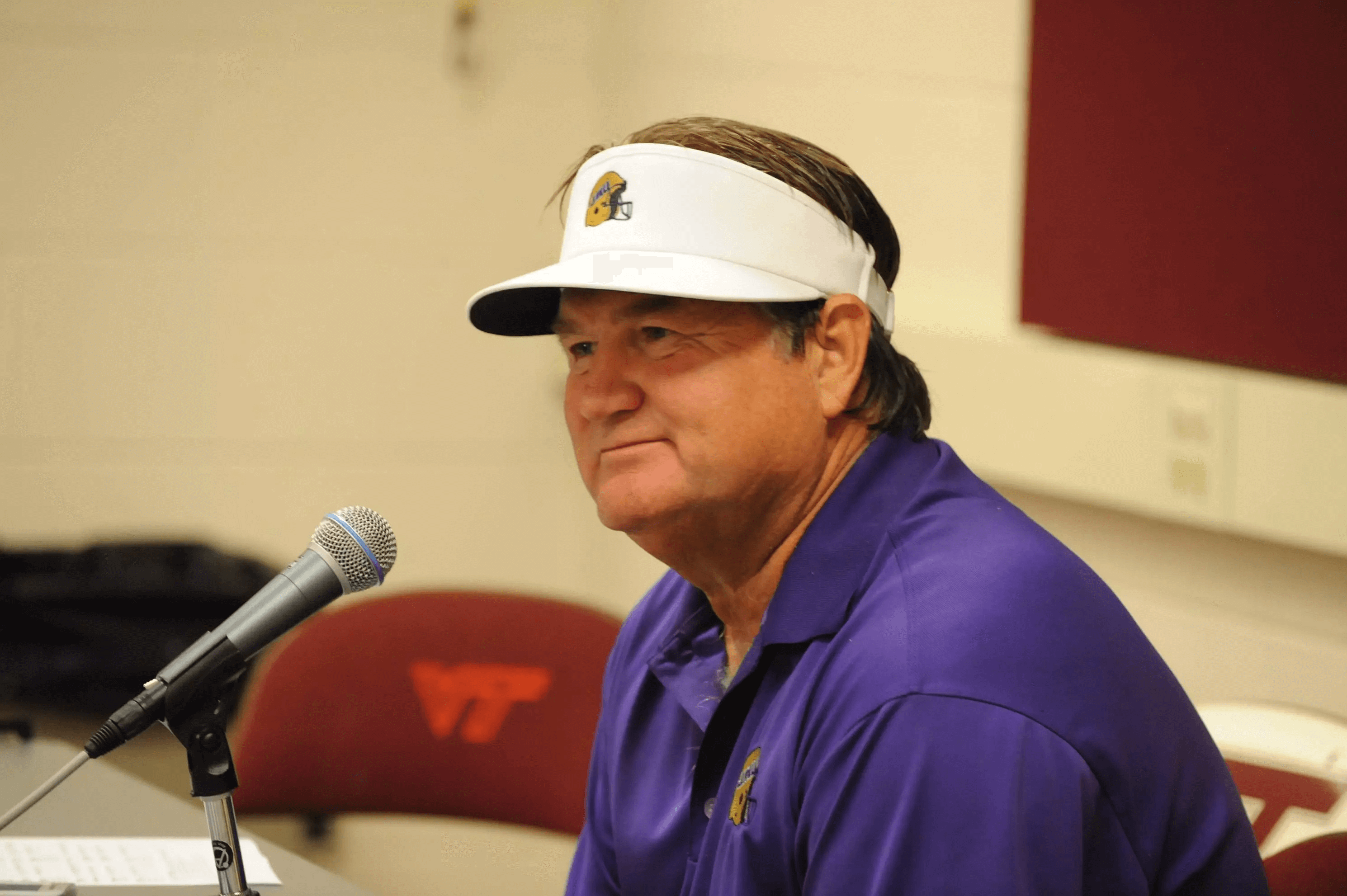Story by Preston Adams
Maurice Fenner ran the ball in from the 1-yard line to score a JMU touchdown. The Dukes regained the lead 24-21 over Montana.
JMU had turned the ball over the previous drive, and Montana quickly capitalized by taking a 21-17 lead. The games JMU played during the 2004 season and a senior laden team would not have the Dukes phased as they marched down the field on the next drive to take the lead once again and never give it up.
This is how JMU rallied to win the football national championship in 2004. It’s also the story of a championship team that laid the foundation for football excellence to come.
Matthews’ Early Days
“It was a total rebuild, it was like JMU had never played football before,” Mickey Matthews told Dave Riggert.
This quote from Matthews shows how dire the situation was at JMU following the 1999 season, a season in which the Dukes actually won the A-10 conference. But, Matthews had a tough task on his hands, and it would not be immediate success with his first ever recruiting class. The first two years of the recruiting class were rough, with JMU having losing seasons. There were signs of hope though when the Dukes went 6-6 in 2003.
There seemed to be something on the horizon for the Dukes.
Special 2004 Team
“I think we knew going into the year it would be a special year,” Trey Townsend said in another interview with Riggert. “We had a lot of three-year starters … We had a lot of trust built among one another.”
The former standout linebacker was not wrong in any of these assessments. Much of JMU’s first recruiting class under Matthews redshirted their freshman year, and were seasoned veterans by the time 2004 rolled around. Even Matthews had a quiet confidence saying, “You’re never gonna predict in August that you’re gonna win a national championship, but we knew we were gonna be good”.
That team cohesion would immediately be tested as JMU had a quarterback battle going into camp. Matt Lezotte was the talented incumbent, but was prone to injury. Justin Rascati was a transfer from Louisville and even though his arm was not as good as Lezotte’s, he was the kind of quarterback Matthews loved — one who was also a threat in the run game. Rascati ended up winning the starting job, and the Dukes would start the season flying.
Apart from losing to West Virginia, JMU looked like a team on a mission. They won eight of their first nine games, including two Matthews said were the toughest of the season, Maine and Delaware.
“They had three times more yards than us. They were better than us,” Matthews said of Delaware.
But he also said this, which was a staple of the JMU team in 2004 and something that persists to this day: “We had a team that refused to lose.”
They lost the next week, though, in a game against William & Mary.
“The stadium was silent as the ball went through,” Townsend said of JMU losing on a last-second field goal.
“The loss was a little bit of a wake up call but we continued the same mindset of being prepared and playing hard,” he added.
The mindset propelled JMU to rattle off four straight road wins, including a revenge game against William & Mary in the semifinals of the 1-AA playoffs. JMU would then go on to beat Montana 31-21 in the national championship game, on a field that Matthews said was, “The worst field I have ever seen.”

The New Standard
So what are some of the characteristics from this 2004 team that have helped build JMU into the FBS program that it is today?
Well, I think it’s pretty obvious that winning culture is one of them. It’s a term that is thrown around a lot in sports, but JMU has it in football, and across all of its sports. JMU has not had a losing football season since 2002.
In a quote from a playoff pregame speech in 2016, then JMU coach Mike Houston said, “The standard is the standard.” That standard started with Mickey Matthew’s first recruiting class and that 2004 national championship.
Another staple of that 2004 national championship team was a staunch defense. They allowed only 2.5 yards per carry and gave up a little over 16 points per game. With the exception of a couple years following Matthews, JMU prides itself on hard-nose defense and stopping the run.
Townsend talked about having an eight-man front in 2004 because they could trust the safeties and cornerbacks that much. No one is doing that two decades later, as the game has become more pass happy in the years since, but it illustrates JMU’s commitment to stopping the run, and how it still continues.
Another staple of that 2004 team was having a stable of running backs. When Alvin Banks and Maurice Fenner went down due to injury, Redshirt Junior Raymond Hines picked up the ball and ran JMU all the way to the semifinals before finally burning out. From there, since the season went on so long, a healthy Banks and Fenner were able to help carry JMU over the line, and absolutely dominated the championship game on the ground.
JMU continues to carry on the tradition by having a deep and diverse running back room, and usually a quarterback that compliments them well with his legs.
Something else noticeable from that 2004 season is the number of close games JMU played. The Dukes’ first two playoff victories were by a score of 14-13. JMU was playing incredibly competitive games in the A-10.
If you look at the years after, you’ll also notice that JMU would rarely, if ever, get blown off the field by a team at the same level of competition. In the A-10, CAA, and now Sun Belt, JMU will blow the doors off their competition from time to time, but they don’t get blown out. In two years in the Sun Belt, the Dukes’ largest loss to a conference opponent was a 14-point loss to Marshall in 2022 with starting quarterback Todd Centeio injured.
That “we refuse to lose” attitude still permeates the walls at the Plecker Center, and it’s what makes losses so hard for fans and players. Every team wants to think they can win any game any time they step between the lines. JMU believes it at its core, and it all started in 2004.
Looking Back Fondly
JMU’s President Linwood Rose and Athletic Director Jeff Bourne were at the helm when the Dukes won that first football national championship in 2004. They were putting the vision of former President Ronald Carrier in motion. He wanted JMU to become both an academic and athletic power. While field hockey had won a national championship of their own in 1994, the 2004 football national championship would set the athletic department on a trajectory that has made it one of, if not the most successful and balanced “mid-major” school when it comes to athletics. The standard is the standard across the board, and it began with JMU football in 2004.
On Sept. 6, Mickey Matthews and the 2004 JMU national championship winning team were inducted to the JMU Hall of Fame. Most fans would say that was a no-brainer and others may even ask what took them so long.
Mickey Matthews and the 2004 JMU football team being recognized at yesterday’s game. pic.twitter.com/pyo72FWV0H
— Tommy Gurganous (@TommyGurganous) September 8, 2024
Along with this induction has been a lot of reflection and reminiscing. While I was not at JMU during this championship run, doing the research and seeing old videos made me feel some kind of way, as if I was there. I think that’s because it was during that season that the JMU football DNA we know today was started. Streamers flying from the stands in the 2004 national championship and beating conference rivals in classic match ups are something all JMU fans know and love.
The 2004 national championship team did more than just win a title. They were the beginning of a legacy or winning football that has led the Dukes to where they are today. The standard is the standard, and that standard started in 2004.
Photo courtesy of JMU Athletics Communications


Leave a Reply